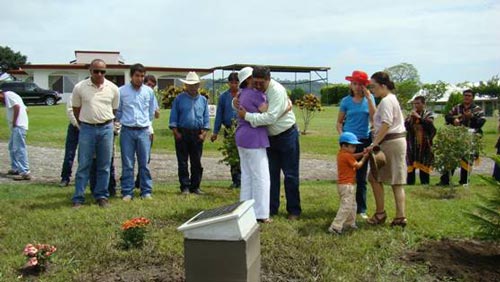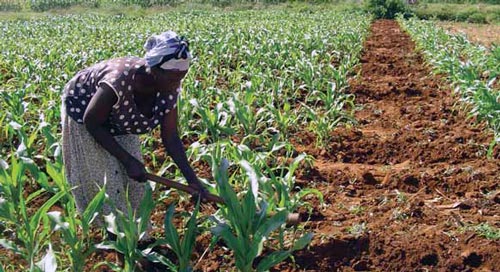CIMMYT experts lead data training course in Peru
 Two CIMMYT-Mexico department heads, along with Mateo Vargas from Mexico’s Chapingo Autonomous University, traveled to Peru this July to lead a five-day training course on field data analysis, with an emphasis on maize. The course, coordinated by Luis Narro of CIMMYT-Colombia, ran from 19-23 July 2010 at the campus of Universidad Nacional Agraria La Molina (UNALM), in Lima, Peru.
Two CIMMYT-Mexico department heads, along with Mateo Vargas from Mexico’s Chapingo Autonomous University, traveled to Peru this July to lead a five-day training course on field data analysis, with an emphasis on maize. The course, coordinated by Luis Narro of CIMMYT-Colombia, ran from 19-23 July 2010 at the campus of Universidad Nacional Agraria La Molina (UNALM), in Lima, Peru.
Twenty-three fellow scientists and researchers (six were women) attended the course, which received Peruvian government funding specifically earmarked for CGIAR initiatives. Other sponsors included the university; the National Institute of Agricultural Innovation (INIA, part of the Peruvian Ministry of Agriculture); CIMMYT; and the institutions of attendees (six Peruvian universities, one Colombian university, and the International Potato Center, CIP).
CIMMYT’s José Crossa (head of Biometrics & Statistics), along with Vargas, filled two of the days with information on theory, analysis, and interpretation of experiment data (including full blocks at random and incomplete blocks); and stability analysis (regression models, AMMI, SREG, PLS, hereditability, and genetic correlations). Statistical analysis software (SAS) was used to analyze all the information.
Later in the week, Kai Sonder (head of the Geographic Information Systems Unit, GIS, part of the Socioeconomics Program) switched gears slightly and focused the following three days on GIS issues. He used local examples and data to show how to apply GIS to agricultural research, how to generate geo-referenced data with GPS in the field, and how to create maps and spatial data using the freeware applications DivaGIS and Geoda. All the participants received a DVD with spatial data and materials and programs used in the workshop. Complementing the workshop, Crossa also presented a conference on how to use phenotypic and genotypic data from multi-location trials to increase the genetic gain of selections. Held in UNALM’s auditorium for their postgraduate program, 50 people attended, including workshop participants, UNALM professors, and researchers from INIA and CIP.
The attendees thanked CIMMYT for organizing the event and others of its caliber, and highlighted the excellent quality of the course and the expertise of the workshop leaders. CIMMYT-Colombia thanks its CIMMYT-Mexico colleagues for their collaboration.

 With much appreciated assistance from public and private sector maize extension specialists and innovative farmers, the first part of a two-part CIMMYT-hosted training course titled “Integrated management of maize-based cropping systems” was successfully completed last week in Mexico. Thirty-two participants attended the course, which ran from 26-30 July 2010 and focused on agronomy and pest management.
With much appreciated assistance from public and private sector maize extension specialists and innovative farmers, the first part of a two-part CIMMYT-hosted training course titled “Integrated management of maize-based cropping systems” was successfully completed last week in Mexico. Thirty-two participants attended the course, which ran from 26-30 July 2010 and focused on agronomy and pest management.
 History was in the making at El Batán last Friday, 30 July 2010. After months of training, studying, and practical application, four ASGROW technicians successfully completed a written and applied test on conservation agriculture (CA), achieving the first-ever CIMMYT-approved CA certifications. This was part of a CIMMYT-led initiative to disseminate CA in central Mexico. For three years CIMMYT has been partnering with SAGARPA-Fondo Borlaug, Fundación Produce Estado de México, and Monsanto to establish sustainable agriculture in the Mexico’s central highlands.
History was in the making at El Batán last Friday, 30 July 2010. After months of training, studying, and practical application, four ASGROW technicians successfully completed a written and applied test on conservation agriculture (CA), achieving the first-ever CIMMYT-approved CA certifications. This was part of a CIMMYT-led initiative to disseminate CA in central Mexico. For three years CIMMYT has been partnering with SAGARPA-Fondo Borlaug, Fundación Produce Estado de México, and Monsanto to establish sustainable agriculture in the Mexico’s central highlands. On 30 June 2010, a USAID Famine Seed Project meeting was organized at CIMMYT’s South Asia Office in Kathmandu, Nepal. Seventeen participants, including those from the Nepal Agriculture Research Council (NARC), CIMMYT-Nepal, CIMMYT-Bangladesh, and Cereal Systems Initiative for South Asia (CSISA) HUB partners in Nepal, attended the meeting. The objectives of the day were to: (1) review 2009-10 crop cycle work and progress, (2) to develop a work plan for the upcoming 2010-11 cycle and, (3) to strengthen collaboration with technology-delivering stakeholders.
On 30 June 2010, a USAID Famine Seed Project meeting was organized at CIMMYT’s South Asia Office in Kathmandu, Nepal. Seventeen participants, including those from the Nepal Agriculture Research Council (NARC), CIMMYT-Nepal, CIMMYT-Bangladesh, and Cereal Systems Initiative for South Asia (CSISA) HUB partners in Nepal, attended the meeting. The objectives of the day were to: (1) review 2009-10 crop cycle work and progress, (2) to develop a work plan for the upcoming 2010-11 cycle and, (3) to strengthen collaboration with technology-delivering stakeholders.
 An advanced maize breeding course covered subjects such as doubled haploid technologies, screening, quantitative genetics, hybridization, molecular markers, and precision agriculture, and was taught by CIMMYT’s George Mahuku and Luis Narro, FENALCE’s José Ever Vargas Sánchez, and Argemiro Miguel Moreno Berrocal of CENICAFE. A statistics workshop, given by Norbey Marín Arredondo, consultant statistician and professor at Universidad ICESI, introduced participants to the use of SAS in experimental design and analysis.
An advanced maize breeding course covered subjects such as doubled haploid technologies, screening, quantitative genetics, hybridization, molecular markers, and precision agriculture, and was taught by CIMMYT’s George Mahuku and Luis Narro, FENALCE’s José Ever Vargas Sánchez, and Argemiro Miguel Moreno Berrocal of CENICAFE. A statistics workshop, given by Norbey Marín Arredondo, consultant statistician and professor at Universidad ICESI, introduced participants to the use of SAS in experimental design and analysis. The Chinese Academy of Engineering honored Zhonghu He, principal scientist of CIMMYT’s Global Wheat Program and China country representative, for his work with wheat quality improvement and promotion of China-CIMMYT collaboration. Zhonghu received the Guanghua Award in a ceremony on 09 June 2010 in Beijing. Established in 1996, this award recognizes Chinese scientists who have made signification contributions in applied science and management. To date, only eight scientists with agriculture or forestry backgrounds have received the Guanghua Award.
The Chinese Academy of Engineering honored Zhonghu He, principal scientist of CIMMYT’s Global Wheat Program and China country representative, for his work with wheat quality improvement and promotion of China-CIMMYT collaboration. Zhonghu received the Guanghua Award in a ceremony on 09 June 2010 in Beijing. Established in 1996, this award recognizes Chinese scientists who have made signification contributions in applied science and management. To date, only eight scientists with agriculture or forestry backgrounds have received the Guanghua Award. With the words “congratulations for the good work of your teams,” on 18 June 2010 the Consortium Board returned its feedback on the MAIZE and WHEAT Mega-Program proposals recently-submitted by CIMMYT, in conjunction with IITA and ICARDA. Consisting of comments from three external reviewers and the Board itself, the critiques praise the proposals but lay out suggestions for improvement that include clarifying impact pathways and interactions and boundaries with other CGIAR initiatives; elaborating on partnership strategies; further analyzing gender issues; finalizing management approaches; and defining how the Mega-Programs will be monitored and evaluated.
With the words “congratulations for the good work of your teams,” on 18 June 2010 the Consortium Board returned its feedback on the MAIZE and WHEAT Mega-Program proposals recently-submitted by CIMMYT, in conjunction with IITA and ICARDA. Consisting of comments from three external reviewers and the Board itself, the critiques praise the proposals but lay out suggestions for improvement that include clarifying impact pathways and interactions and boundaries with other CGIAR initiatives; elaborating on partnership strategies; further analyzing gender issues; finalizing management approaches; and defining how the Mega-Programs will be monitored and evaluated.